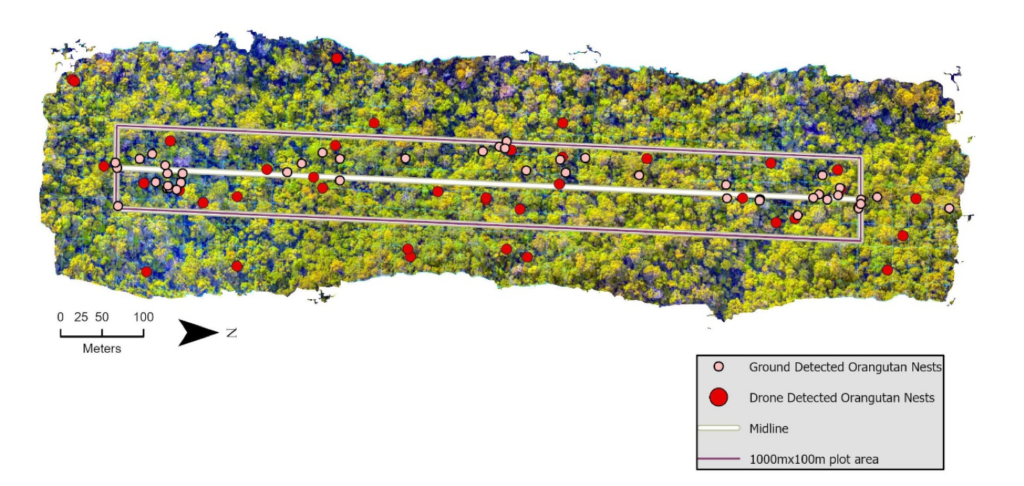
An example of a completed orthomosaic after overlaying both drone and nest ground points for comparison.
Orangutan Population Monitoring Project
In order to monitor the population of orangutans in Gunung Palung National Park, we conducted a year-long series of ground and drone surveys across 8 habitat types in 2019-20. By counting orangutans nest on transects from the ground, and aerially via drone imagery, we can estimate the number of orangutans likely to inhabit the area. We are generating habitat specific conversion factors to estimate orangutan populations. We are also using drones to monitor forest degradation and forest fires, so we can better understand orangutan distributions and forest status to improve and target conservation efforts.
Rangkong Project
This research project seeks to improve our understanding of orangutans in degraded habitats in conjunction with our long-term study of orangutans in primary forest. We’ve selected an area called the Rangkong, which is a selectively logged forests just outside of Gunung Palung National Park, to build our new research camp. Our research goals are to investigate how orangutans use degraded habitats to understand orangutans’ population resilience in semi-logged areas. Although, these areas may have lower biodiversity, they may still represent areas of value to orangutans and other species, particularly because of fruit availability from pioneer and invasive species which thrive in the gaps caused by logging. We will also use genetics to assess if orangutans from the primary forest also use this degraded habitat, as well as investigating population relatedness. An additional method we’re employing is bio-accoustic monitoring to identify orangutan male presence by recording long calls. We will compare male presence, human noise, and animal biodiversity between the disturbed and undisturbed forest. Finally, monitoring of orangutan health in this area also provides information on potential impacts on orangutans from habitat disturbance or human contact. As the Rangkong is used by both humans and orangutans, there is potential for human-orangutan conflict. By researching how humans and wildlife use this habitat, we can reduce the potential for human-orangutan conflict to advance orangutan conservation efforts.
Related Publications
Seidlera, R, RB Primack, VR Goswami, S Khaling, MS Devy, RT Corlett, CD Knott, EE Kane, TW Susanto, E Otali et al. (2021). Confronting ethical challenges in long-term research programs in the tropics. Biological Conservation, 108933.
Knott CD, EE Kane, M Achmad, B Barrow, ML Bastian, J Beck, AB Blackburn, TL Breeden, CL Conklin-Brittain, JJ Brousseau, et al. (2021). The Gunung Palung Orangutan Project: Twenty-five years at the intersection of research and conservation in a critical landscape in Indonesia. Biological Conservation. 225:108856 https://doi.org/10.1016/j.biocon.2020.108856.
Norconk MA, S Atsalis, G Tully, A Santillán-Doherty, S Waters, CD Knott, SR Ross, S Shanee, and D Stiles (2019). Reducing the live primate trade: actions for primatologists. American Journal of Primatology. DOI: 10.1002/ajp.23079
Freund, CA, M Achmad, P Kanisius, R Naruri, E Tang, and CD Knott. (2019). Conserving Orangutans One Classroom at a Time: Evaluating the Effectiveness of a Wildlife Education Program for School-Aged Children in Indonesia. Animal Conservation. 23 (1): 18-27. doi.org/10.1111/acv.12513
Freund CA, E Rahman and CD Knott. (2016). Ten Years of Orangutan-Related Wildlife Crime Investigation in West Kalimantan, Indonesia. American Journal of Primatology. 78: 1-11.
